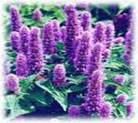Scientific Classification:
|
Other Common Names:
The other common name for the herb hyssopus officinalis are hyssop.
History

Description


Range
It was originated in Southern Europe and spread throughout Europe by the invading Roman armies. Common in the Midi region of France and cultivated in gardens as an aromatic and medicinal herb. It is stated to be naturalized on the ruins of Beaulieu Abbey in the New Forest.
Habitat
They are generally grown in gardens and prefer a soil condition of moist and well drained. It grows wild in France in rocky soil and on old ruins; in Britain it is often found in garden borders or hedges, mixed with rosemary, catmint and lavender.
Cultivation
Hyssops is propagated by seeds, sown in April, or by dividing the plants in spring and autumn, or by cuttings, made in spring and inserted in a shady situation. Hyssop prefers light, friable, well-drained soil. It will grow in either a sunny or semi-shaded position. Seeds can be planted in spring either by cutting or other method and once when they reach the required growth should be planted out about 1 foot apart each way, and kept watered till established. They succeed best in a warm aspect and in a light, rather dry soil. In autumn, new plants can be created by root division. Pruning after flowering will create a more compact plant and better flowering in the following year. This plant is often used as a border plant in herb gardens as it lends itself well to hedging and generally grown with catmint. The flower-tops should be cut in the month of August if it is going to be used for medicinal purpose.
Flowering Season
Hyssops generally bloom in the months of late summer and early spring.
Pests and Diseases
Generally these herbs are not affected by any pests or diseases but very rarely they are infected by aphids and whiteflies which may be washed away with a spray of water.
Parts Used
Generally the dried aerial parts of the plant are used for medicinal purposes. The leaves are most of the time are of culinary use.
Medicinal Applications

- It was used in protection against plague and for its aphrodisiac effect in conjunction with ginger, thyme and pepper.
- It is recommended for coughs, colds,’ flu, bronchitis, asthma and chronic catarrh.
- It is employed in the manufacture of perfumes and liqueurs, forming an important constituent in Chartreuse.
- The leaves are used locally as medicinal tea well adapted to improve the tone of a feeble stomach, being brewed with the green tops of the herb, which are sometimes boiled in soup to be given for asthma.
- The infusion of the leaves is used externally for the relief of muscular rheumatism, and also for bruises and discoloured contusions, and the green herb, bruised and applied, will heal cuts promptly.
- Hyssop boiled with honey and Rue, and drank, helps those that are troubled with coughs, shortness of breath, wheezing and rheumatic distillations upon the lungs.
- It is also used to remove bruises and scars and as a treatment for dental cavities, both by the Ancient Greeks and by the Indians.
- It is also considered for relieving gas or intestinal cramping than for easing a cough.
- The infusion also is an excellent digestive tonic and helps cure as disparate disorders as weak digestions and rheumatism.
- It is used in treatment of swelling and bruising.
- It is useful as a remedy for nervous complaints like anxiety and depression.
Commercial Applications
- It can be used in soups, stuffings and sauces. The sweetly scented flowers make an interesting addition to salad greens.
- Hyssop oil is used widely in the perfume industry and hyssop tea was used to treat many ailments including digestive and intestinal problems, throat infections, rheumatism and insomnia.
- It is mostly used for broths and decoctions.
- Lotion of hyssop was said to improve skin colour and texture.
- Hyssop leaves are often used to flavour salads, stews and marinades.
- The flowers can also be used to garnish dishes and in salads.
- Hyssop is added to potpourri.
Folklore and Myths
The genus name, Equisetum, translates to "horse-bristle" or tail, describing the appearance of the sterile stems. Deposits of silica cover the vegetative stems and branches of field horsetail. For this reason, the plant has been used to scour pots, pans, and articles containing silver (hence the common name 'scouring rush').Field horsetail may accumulate more gold than any other plant. Up to 4 1/2 ounces of gold per ton of fresh plant material has been recovered. Mining engineers consider field horsetail an indicator species of gold, but not a viable commercial source.

